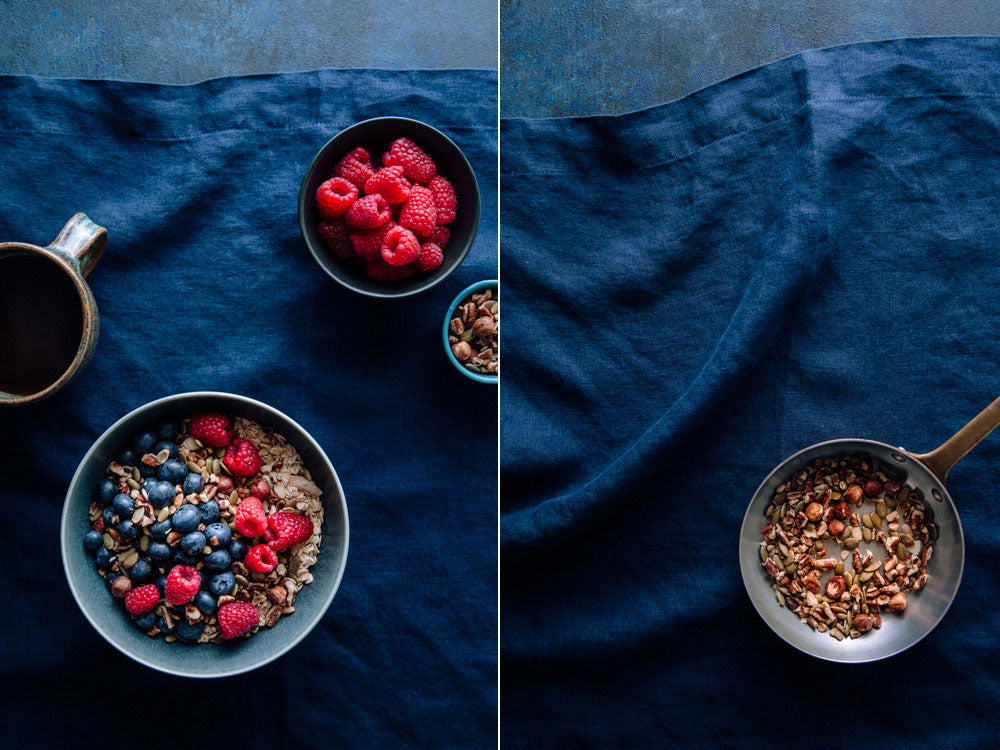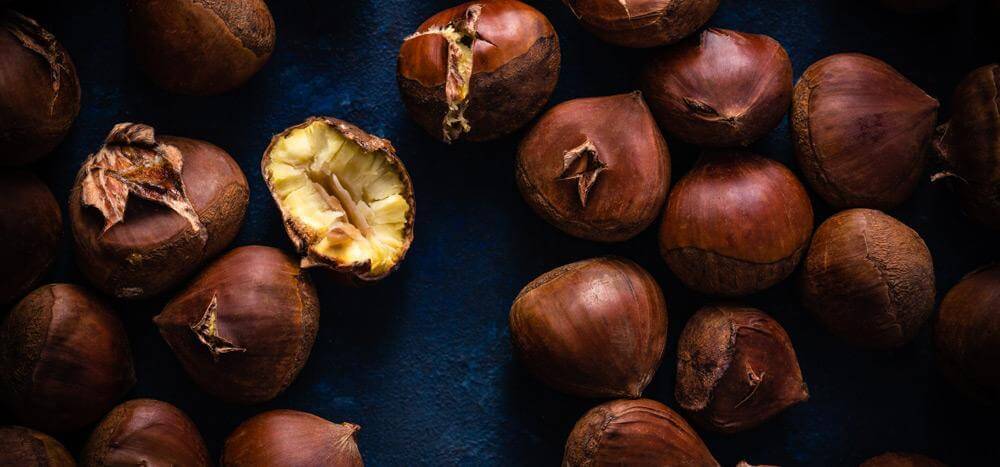We all know that great photography requires a lot of gear.
However, one bonus of shooting food is that you don’t need a lot of photography equipment to start. In fact, you don’t even need studio lighting because you can use natural light in a lot of scenarios.
Let’s take a look at the basic food photography equipment required for taking drool-worthy images of food.
Camera
One of the most important factors in your camera body is the size of the sensor.
Cameras with a cropped sensor are cheaper for manufacturers to produce, thereby making good DSLR’s accessible to more consumers. A camera with a full-frame sensor will provide the higher resolution required for most commercial photography applications.
Every camera has a crop factor, which photographers use to describe how much the camera is cropping a given image in relation to the standard 35mm.
A full-frame camera has a sensor size of 24mm x 36mm and matches the 35mm cropped standard of a traditional film camera. It. A cropped sensor is smaller, giving you an image that looks a lot more cropped in.
For example, a Canon Rebel has a crop factor of 1.6. If you multiply 1.6 times the focal length of your lens, you’ll get the focal length that it appears you took your pictures at.
For instance, if you put a 50mm on a full-frame camera, it will work like a 50mm. What you see is what you get. Put that same lens on a camera with a cropped sensor, it works more like an 80mm.
So basically, your lenses will function differently, based on the size of your sensor.
Also, be aware that some lenses don’t fit on cameras with a cropped sensor. If you’re planning to eventually upgrade your photography equipment and go from a cropped sensor camera to a full-frame, this is something you need to pay attention to when purchasing lenses.

Lenses
The quality of your lens is more important to your photography than the quality of your camera body. You should spend the biggest chunk of your budget on your lenses.
Luckily, you don’t need a lot of different lenses in your kit of photography equipment. In fact, two good-quality lenses will cover most of your bases in food photography.
Ultimate sharpness is the goal in food photography, therefore most photographers prefer prime lenses. Zoom lenses have moving parts required to change the focal length and influence sharpness and image quality.
Prime lenses are usually ‘faster’. They have a larger maximum aperture, which enables quicker shutter speeds. They also give you a tighter depth-of-field, allowing you to isolate your subject and get the blurred out background that’s so sought after in food photography.
The Best Lenses for Food Photography
The 50mm Lens
If you’re just starting out in food photography and have a camera with a cropped sensor, a 50mm will give you a lot of options and is a great lens to have in your kit. It’s known as the “nifty-fifty” because it offers good quality for a relatively low price.
If you have a full-frame camera, this lens works best for wider shots, such as tablescapes and overhead shots. Many photographers consider the 50mm a wide-angle lens in food photography. It’s not always the best option when shooting at a 45-degree angle because of distortion issues.
The 24-70mm Lens
Although many photographers prefer primes in food photography, it’s very useful to have one high-quality zoom lens in your kit. The 24-70mm is the most popular zoom lens with food photographers.
It’s very sharp for a zoom lens, and incredibly versatile because it offers the most common focal lengths used in food photography.
The 60mm Macro
If you’re shooting with a cropped sensor, then a 60mm macro is a great choice. It’s comparable to using a 100mm on a full-frame camera.
This lens allows you to shoot your subjects at 45-degrees, with nice bokeh and without the distortion of a lens with a wider focal length, like the 50mm.
If you upgrade to full-frame, you can use the 60mm macro like you would a 50mm.
The 100mm Macro
If I could only have one lens in my kit, this would be the one.
The 100mm Macro is excellent not only for macro or close up shots, you can also get very nice portrait-style shots as well, by pulling further away from your set. The focal length will give you a great blurred out background. In this case, you’re not actually using the macro capabilities of the lens.
A 100mm/105mm macro lens on a cropped sensor will give you a focal length of around 150mm. This is a very tight crop and is not ideal if space is an issue.

Tripod
If you’re not used to working with a tripod or think it’s too “limiting” in food photography, then you need to think again.
The best way to get hundreds of terrible pictures that all look the same is to crouch down and circle your set with your camera, like a predator stalking its prey. You need to free up your hands to style your food according to what you see in the camera viewfinder. Using a tripod will also help you create consistent images from shot to shot, which is really important when photographing a series.
When shopping for a tripod, stability is the most important factor. A tripod needs to be able to handle a high payload — that is, the weight of your camera and lens, and any accessories like an extension arm.
Look for one with both adjustable height and orientation — a center column that you can move, and ensure that it has rubber feet to avoid any slippage.
Lens Filters and Lens Hood
Lens filters may seem like an unnecessary expense when putting together a kit of food photography equipment. But a couple of the right lens filters can go a long way in protecting your lenses and improving the look of your food photos.
First of all, you should have a good quality UV filter on your lens at all times to protect it from dust and scratches.
A circular polarizing filter will greatly reduce any shine or glare in your images caused by reflective items like cutlery and glassware, which are the bane of every food photographer’s existence.
You should also have a lens hood for further protection. I once tripped over a tethering cord and my camera took a nosedive off my table. While the filter cracked, my lens was intact. A fifty dollar lens hood saved me from a broken $3000 lens. A lens hood will also prevent the light from hitting the front lens element from the sides and creating flare.

Tethering Cord
A tethering cord will allow you to hook up your camera to your computer so you can see a larger and more accurate rendition of your image file than you can on your camera’s LCD screen.
When working with clients and art directors, it’s really important for them to be able to see the image to provide feedback and creative direction. Even if you’re working alone, it will help you place the various elements on set and to see details that you might not otherwise catch.
To tether your computer to your camera, you need a USB 2.0 to Mini B 5-pin cable. Look for a cord that has gold tips, so they won’t get corroded easily.
Reflector Kit with Diffuser
A reflector kit is a relatively inexpensive photography equipment purchase that can make a big difference in your food photography.
It includes foldable discs that come with gold, silver, white, and black materials. You can use them interchangeably, depending on how you want to direct your light. The gold reflector adds warmth to your subject, while the silver brightens it.
These kits usually come with diffusion disks as well. Diffusers are really important in food photography because they soften the light and affect how much light hits your set. If you’re working in strong sunlight or using a studio flash, a large diffuser will keep too much light from spilling onto your subject and creating hard shadows.

Conclusion
While getting together even the most basic photography kit can be very expensive, you can end up spending more in the long run if you buy a lot of cheap gear that you’ll have to replace in a year.
The best course of action is to buy only what you really need but the best you can afford. Once you save more money or start bringing in more clients, you’ll be able to add more photography equipment to your food photography studio.
Be sure to read The Gear You Need To Start Your Food Photography Studio Part 2 on Resouce Magazine.

This article was guest authored by our good friend Darina Kopcok.
Darina is a commercial food photographer, writer, and educator based in Vancouver, Canada. You can find her at https://www.darinakopcok.com/
90 Days Of Content
Over the next 90 days we are going to be working with some top artists to explore recommendations giving you solutions to problems we have all gone through. We are paying the writers a really fair wage for every original article, and we are writing about things that aren’t sponsored by any brand. There is no one but our opinion behind it. We would love it if you do use our affiliate links here so we can continue to keep writing awesome articles that you can trust.









